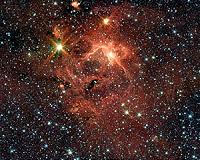 |
Pasadena CA (SPX) Jul 19, 2010 Astronomers at the California Institute of Technology (Caltech) and Ecole Polytechnique Federale de Lausanne (EPFL) in Switzerland have discovered the first known case of a distant galaxy being magnified by a quasar acting as a gravitational lens. The discovery, based in part on observations done at the W. M. Keck Observatory on Hawaii's Mauna Kea, is being published in the journal Astronomy and Astrophysics. Quasars, which are extraordinary luminous objects in the distant universe, are thought to be powered by supermassive black holes in the cores of galaxies. A single quasar could be a thousand times brighter than an entire galaxy of a hundred billion stars, which makes studies of their host galaxies exceedingly difficult. The significance of the discovery, the researchers say, is that it provides a novel way to understand these host galaxies. "It is a bit like staring into bright car headlights and trying to discern the color of their rims," says Frederic Courbin of EPFL, the lead author on the paper. Using gravitational lensing, he says, "we now can measure the masses of these quasar host galaxies and overcome this difficulty." According to Einstein's general theory of relativity, if a large mass (such as a big galaxy or a cluster of galaxies) is placed along the line of sight to a distant galaxy, the part of the light that comes from the galaxy will split. Because of this, an observer on Earth will see two or more close images of the now-magnified background galaxy. The first such gravitational lens was discovered in 1979, and produced an image of a distant quasar that was magnified and split by a foreground galaxy. Hundreds of cases of gravitationally lensed quasars are now known. But, until the current work, the reverse process-a background galaxy being lensed by the massive host galaxy of a foreground quasar-had never been detected. Using gravitational lensing to measure the masses of distant galaxies independent of their brightness was suggested in 1936 by Caltech astrophysicist Fritz Zwicky, and the technique has been used effectively for this purpose in recent years. Until now, it had never been applied to measure the masses of quasar hosts themselves. To find the cosmic lens, the astronomers searched a large database of quasar spectra obtained by the Sloan Digital Sky Survey (SDSS) to select candidates for "reverse" quasar-galaxy gravitational lensing. Follow-up observations of the best candidate-quasar SDSS J0013+1523, located about 1.6 billion light years away-using the W. M. Keck Observatory's 10-meter telescope, confirmed that the quasar was indeed magnifying a distant galaxy, located about 7.5 billion light years away. "We were delighted to see that this idea actually works," says Georges Meylan, a professor of physics and leader of the EPFL team. "This discovery demonstrates the continued utility of gravitational lensing as an astrophysical tool." "Quasars are valuable probes of galaxy formation and evolution," says Professor of Astronomy S. George Djorgovski, leader of the Caltech team. Furthermore, he adds, "discoveries of more such systems will help us understand better the relationship between quasars and the galaxies which contain them, and their coevolution." Other coauthors of the Astronomy and Astrophysics paper, entitled "First case of strong gravitational lensing by a QSO: SDSS J0013+1523 at z = 0.120," are Malte Tewes and Francois Rerat of EPFL, Ashish Mahabal of Caltech, and Dominique Sluse of the Astronomical Research Institute in Heidelberg, Germany. The work done at Caltech was supported by the National Science Foundation and the Ajax Foundation.
Share This Article With Planet Earth
Related Links California Institute of Technology Stellar Chemistry, The Universe And All Within It
 All Stars Are Born The Same Way
All Stars Are Born The Same WayParis, France (SPX) Jul 15, 2010 Astronomers have obtained the first image of a dusty disc closely encircling a massive baby star, providing direct evidence that massive stars form in the same way as their smaller brethren. This discovery, made thanks to a combination of ESO's telescopes, is described in an article in this week's issue of Nature. "Our observations show a disc surrounding an embryonic young, massive star, ... read more |
|
| The content herein, unless otherwise known to be public domain, are Copyright 1995-2010 - SpaceDaily. AFP and UPI Wire Stories are copyright Agence France-Presse and United Press International. ESA Portal Reports are copyright European Space Agency. All NASA sourced material is public domain. Additional copyrights may apply in whole or part to other bona fide parties. Advertising does not imply endorsement,agreement or approval of any opinions, statements or information provided by SpaceDaily on any Web page published or hosted by SpaceDaily. Privacy Statement |